As one of the most respected genres of underground dance music, techno is favoured by many skilled DJs thanks to its rich heritage of long transitions and forward-thinking use of technology.
Synonymous with plenty of iconic DJ staples, such as four-deck mixing, and pioneering the use of laptops, external effects and MIDI devices, techno strikes the perfect mix of cutting-edge and traditional mixing style.
In this tutorial, we break down three key techniques used by the pros to keep the synthesizers and hypnotic basslines flowing, all inspired by our Techno Mixing DJ Course.
They can all be performed on virtually any equipment as they focus on phrasing and using just the volume faders and EQs!
The EQ should ideally have full-kill isolation for best results, but classic EQ will work just fine.
Check out our video tutorial below for a demo and breakdown of these signature techniques with course tutor Danny James, and read on for the full walkthrough!
5 Techno Mix Techniques
#1. Slow EQ Blending
This first method is a great foundational technique for mixing any genre!
As techno mixes can be performed over several minutes rather than seconds, blending slowly is ideal as it helps create a super smooth transition.
This allows DJs to really craft their mix’s sound by gradually adding and subtracting elements, as two tracks mesh together to make a unique new track with its own energy.
In our example, we transition Wehbba Dynamo on Deck 1 into Veerus Bypass on Deck 2.
The decks are loaded with the following Hot Cue time stamps:
Deck 1: A 00:00; B 00:28; C 00:57; D 01:11; E 02:23
Deck 2: A 00:00; B 01:14; C 01:58; D 02:28; E +0
Preparing to Mix
To create a clean transition, start by twisting all of the EQ pots for Deck 2 fully left. This kills off all of the sound. Both decks are set to 134 BPM.
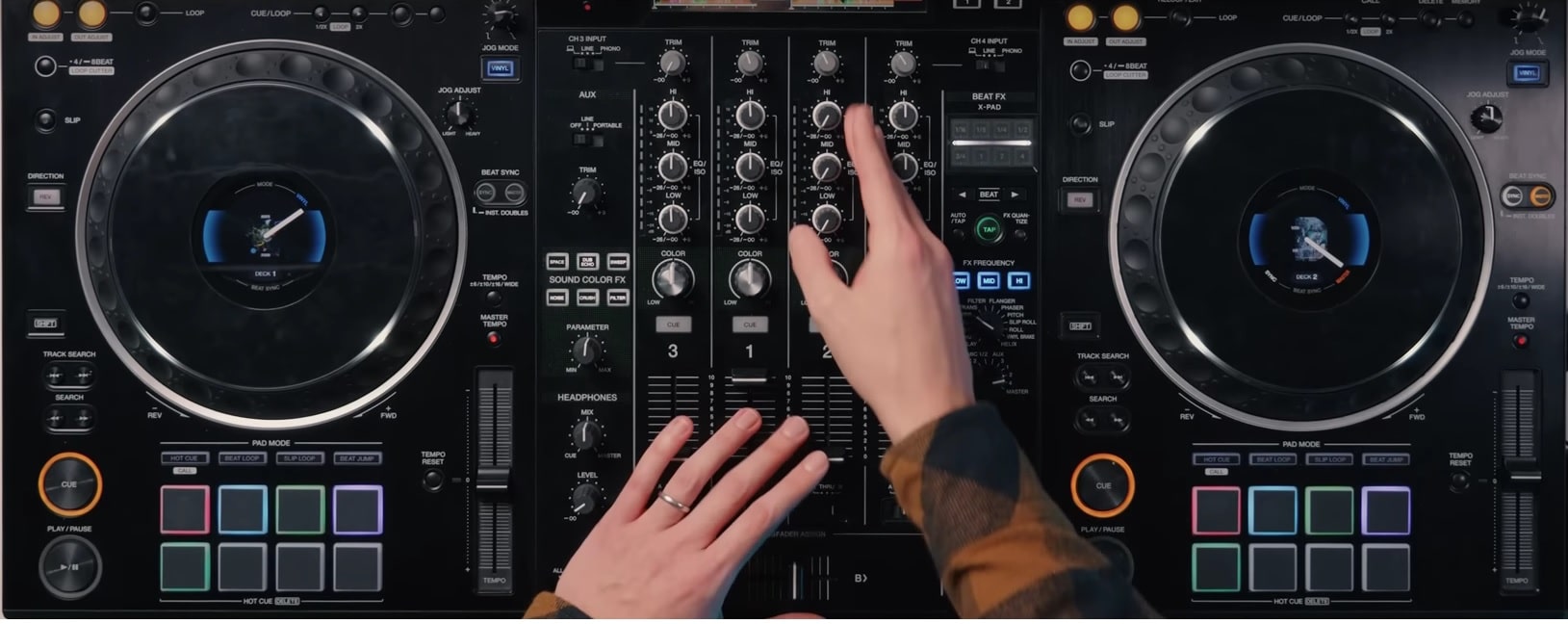
Setting off the mix
Before setting the mix off, open the upfader for Deck 1 and keep it closed for Deck 2. Next, simultaneously hit Hot Cue B for each deck.
Then we slowly introduce the harmonic content of Deck 2 by gradually twisting the MID EQ pot to its central position over the course of about 16 bars from the start of the blend.
We can now hear the string sound of a guitar or harp bleeding through into the mix.
Swapping The High Frequencies
Next, we transition some of the high frequencies by removing highs from Deck 1 whilst adding them from Deck 2.
This involves twisting the HI EQ pot for Deck 1 slowly left whilst twisting the HI EQ pot for Deck 2 slowly right.
The aim at this stage is to get the EQ pots for both Decks 1 and 2 to about 11 O’Clock.
This happens over about 6 bars. We then let the mix sit for a bar before moving on to the next step.
Strip away the low end
It’s now time to reduce the bass on Deck 1. We start twisting its LOW EQ pot to about 11 O’Clock whilst fully introducing the high frequencies by twisting the HI pot to the central position on Deck 2.
We then introduce bass on Deck 2 by twisting the LOW EQ pot to about 9 O’Clock whilst lowering the HI EQ pot on Deck 1 from 11 O’Clock down to 10 O’Clock to help the sounds gel together.
Next, simultaneously twist the LOW EQ pot for Deck 1 to about 8 O’Clock whilst introducing it fairly swiftly to its central position on Deck 2, over about 3 bars.
We now take the upfader for Deck 1 down from volume notch 10 to 8 to remove some of the track’s power.
Even at this lower volume, its stabs are still coming through nicely in the mix as they sit in the middle EQ frequency, which hasn’t been adjusted so far.
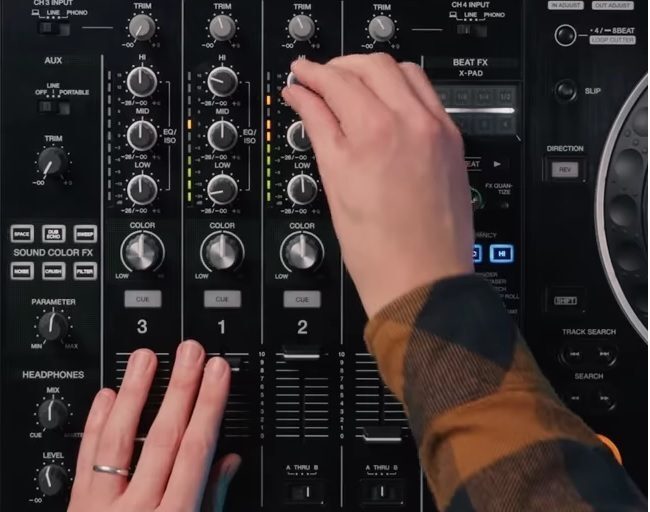
The Final Fade Out
Finally, we completely remove the lows and most of the highs from Deck 1 by twisting the LOW EQ pot fully left and leaving the HI pot at about 7 O’Clock so the higher frequencies are not completely drowned out.
With the MID frequency pot, we slightly boost this to around 1 O’Clock to allow the keyboard stabs to ping through whilst the rest of the track is quietly fading away.
We then slowly pull the Deck 1 upfader down from volume notch 8 to 0 whilst also twisting the MID pot back to the centre and then fully left to kill its sound completely.
By the time the MID pot has been fully twisted left, the upfader is also fully closed, leaving Deck 2 to play alone.
This final part of the fadeaway takes place over about 8 bars. We are then left with Veerus Bypass satisfyingly playing standalone.
#2. Swapping the drops
This technique is all about high energy. As with the slow EQ blend, it involves two tracks in the mix for an extended period.
But here, the tracks have some elements swapped immediately rather than slowly being switched during a blend, creating a sudden spike in energy!
In this example, we mix Don Rimini and Jackin’ Trax Bone Jaw on Deck 1 into a famous techno track, Jeff Mills The Bells, on Deck 2.
Hearing a unique take on a well-known track gives an extra boost to the energy!
The decks are loaded with the following Hot Cue time stamps:
Deck 1: A 00:00; B 00:28; C 00:57; D 01:26
Deck 2: A 00:00; B 00:13; C 00:27; D 00:41; E 00:55
Preparing to Mix
We prepare for the mix again, killing all of the EQ on Deck 2 by twisting all its EQ pots fully left and toggling the EQ setting mode to ISOLATE.
We have the upfader for Deck 1 open and keep it closed for Deck 2. Both Decks are set to 135BPM.
Setting off the mix
We start the mix by simultaneously hitting Hot Cue C on Deck 1 and Hot Cue B on Deck 2.
We then bring Deck 2’s upfader fully up and slowly introduce the high and middle frequencies by twisting the HI and MID EQ pots to the right, stopping briefly at 9 O’Clock.
Swapping the drop
At 01:19 into Bone Jaw, the low-end cuts from the track in a mini breakdown.
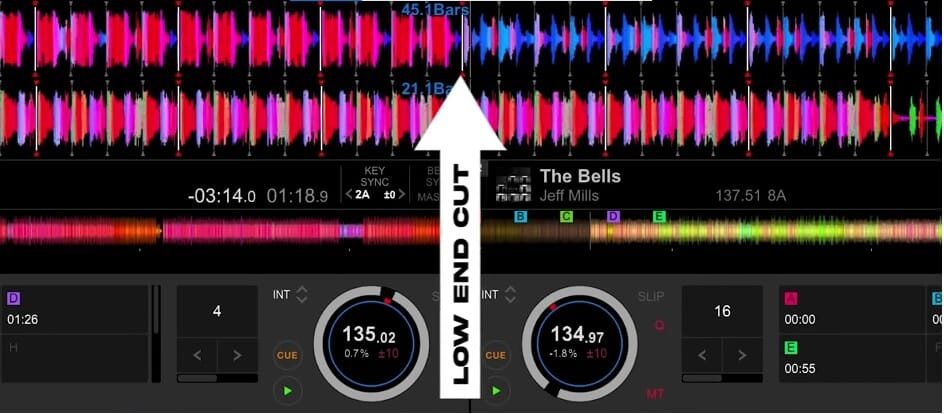
We use this as a cue to kill the low end on Deck 1 by twisting the LOW EQ pot fully left, and then bring in the low end on Deck 2 by twisting its LOW EQ pot to the centre, this results in the bass hitting from The Bells right when it would have hit on Bone Jaw.
So the audience is anticipating a bassline to drop, but instead are treated to another well-known one!
The two tracks now play side by side with unique new energy created by the swapped-in thumping bass of The Bells and the continuing high-end energy coming from the instrumental bells of Bone Jaw.
This can then be faded out as the DJ prefers.
#3. Layering
This technique emulates the use of remix decks, where DJs use multiple decks to separate, group and control different elements of their tracks.
For example, one deck may take care of all the lows, like the kicks and subs of a mix, one deck may take care of the highs and one the mids, whilst a fourth is used to bring a new track into the mix.
The DJ now has ultimate control over their sound and can lower elements, boost elements and completely cut others for effect.
We demonstrate this principle using only two decks, mixing Hi Lo Hera on Deck 1 into UMEK Vibrancy on Deck 2 and then back to Hera again on Deck 1.
The decks are loaded with the following Hot Cue time stamps:
Deck 1: A 00:00; B 00:15; C 00:44; D 01:14
Deck 2: A 00:30; B 01:45; C 02:48; D 03:18; H 05:48
Preparing to Mix
As with the other methods, we start with all the EQ frequencies killed on Deck 2 by twisting its LOW, MID and HI EQ pots fully left and toggling the EQ setting mode to ISOLATE.
We have the upfader for Deck 1 open and keep it closed for Deck 2. Both Decks are set to 130BPM.
Setting off the mix
We start the mix when Deck 1 gets to its initial drop at 02:13 by hitting Hot Cue A on Deck 2.
As we raise Deck 2’s upfader, we also slowly introduce its high frequencies by twisting the HI EQ pot to the 9 O’Clock position.
Then, once the upfader is fully open, we finish introducing the highs by twisting the HI pot to the centre and start to introduce the mid frequencies by twisting the MID EQ pot to the right, quickly transitioning it to its central position.
Now when we listen to the two together, we hear that Vibrancy fills out the sound of the overall mix by adding a shaker to the top end, creating new energy.
Switching the lows
Now we switch the low frequencies by twisting Deck 1’s LOW EQ pot left whilst twisting Deck 2’s LOW EQ pot right. We make the transition over 8 bars.
Now Deck 1 becomes a lone synth line sound for 32 bars whilst the kick and bass from Deck 2 drive the mix forward.
We now simply allow the sounds to gel together.
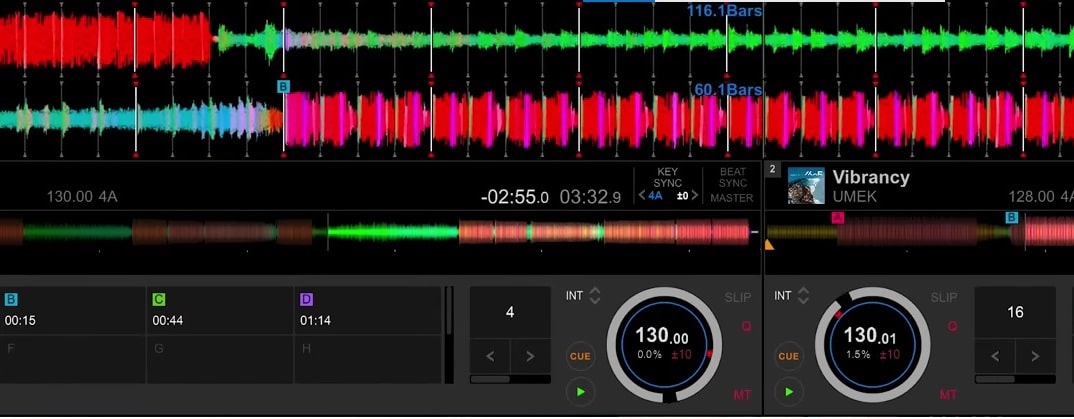
Synth-line in green on Deck 1
Switching the lows back
Then, as the sounds of Hera on Deck 1 begin to build again, we start swapping the lows back over by twisting Deck 1’s LOW EQ pot to the right, stopping at the centre. Whilst twisting Deck 2’s EQ pot fully left throughout the build.
By the time Hera has dropped again, it has all of its elements returned and is leading the mix.
Vibrancy, on the other hand, has now lost all of its bass, so sinks to the background of the mix.
We have now returned to where we were before layering in the Hera synth line. Vibrancy can now fade out to make way for another track to join the journey!

These techniques are a great foundation for DJing in the techno style. If you’d like to take your learning to the next level, our Techno Mixing DJ Course will show you how to create on-point techno mixes in any booth.
Packed with 39 practical lessons, it’s designed for anyone to follow along straight away with any equipment and no unnecessary technicalities.
We take a fully comprehensive look at techno’s many mixing techniques to teach you all the foundational basics right through to the more advanced practices the pros are using right now.
The course also comes with a free subscription to Beatport DJ streaming service so you can start following along right away.
Whether Detroit or Berlin, Acid or Minimal, we’ll get you mixing with confidence!

Techno Mixing DJ Course
7.5 hours
42 lessons
Intermediate
Complete DJ Package
If you want unrestricted access to all of our awesome DJ courses to learn how to mix any genre, signing up to our Complete DJ Package gets you this and so much more!
For a one-off fee, become a lifetime member of Crossfader and get access to tons of bonus content to keep your game fresh, including a Mixing with Stems crash course and loads of artist mix breakdowns.
Plus, we’re on hand to give feedback on your mixes and give technical support in setting up your gear.
Jump into money-back guaranteed success today, check out our Complete DJ Package.

Complete DJ Package
835 hours
1300+ lessons
Creative



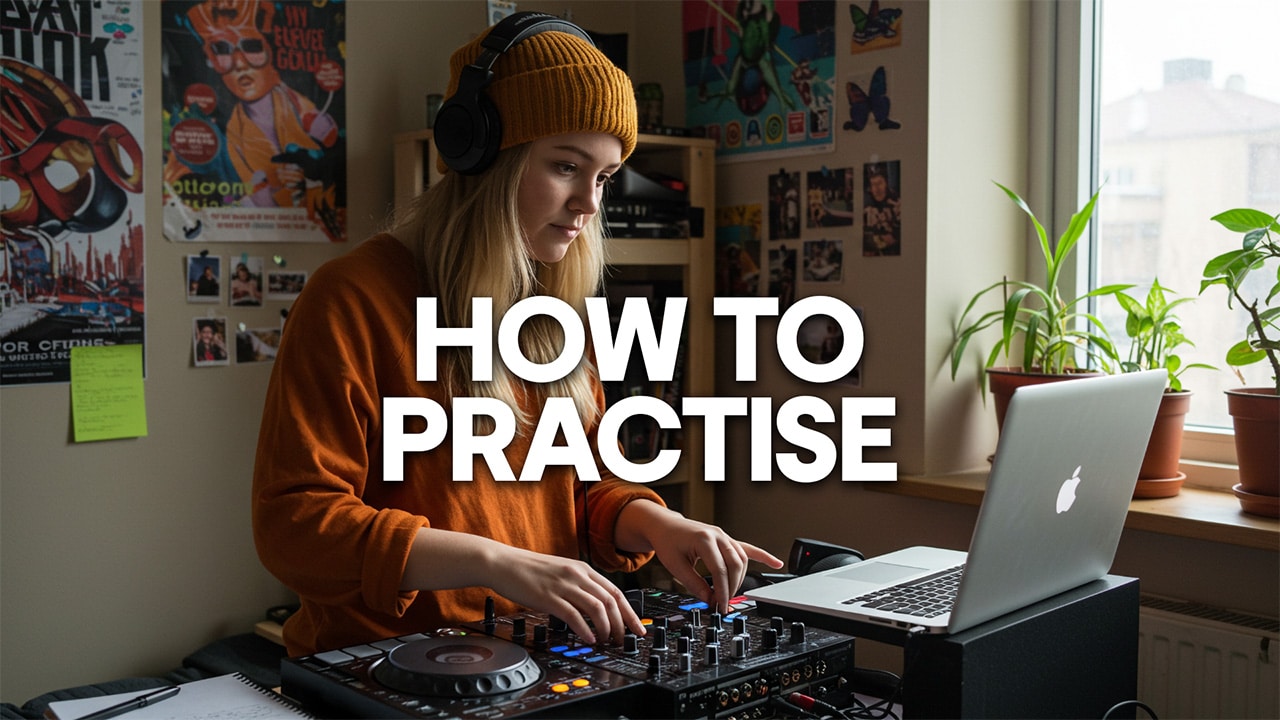
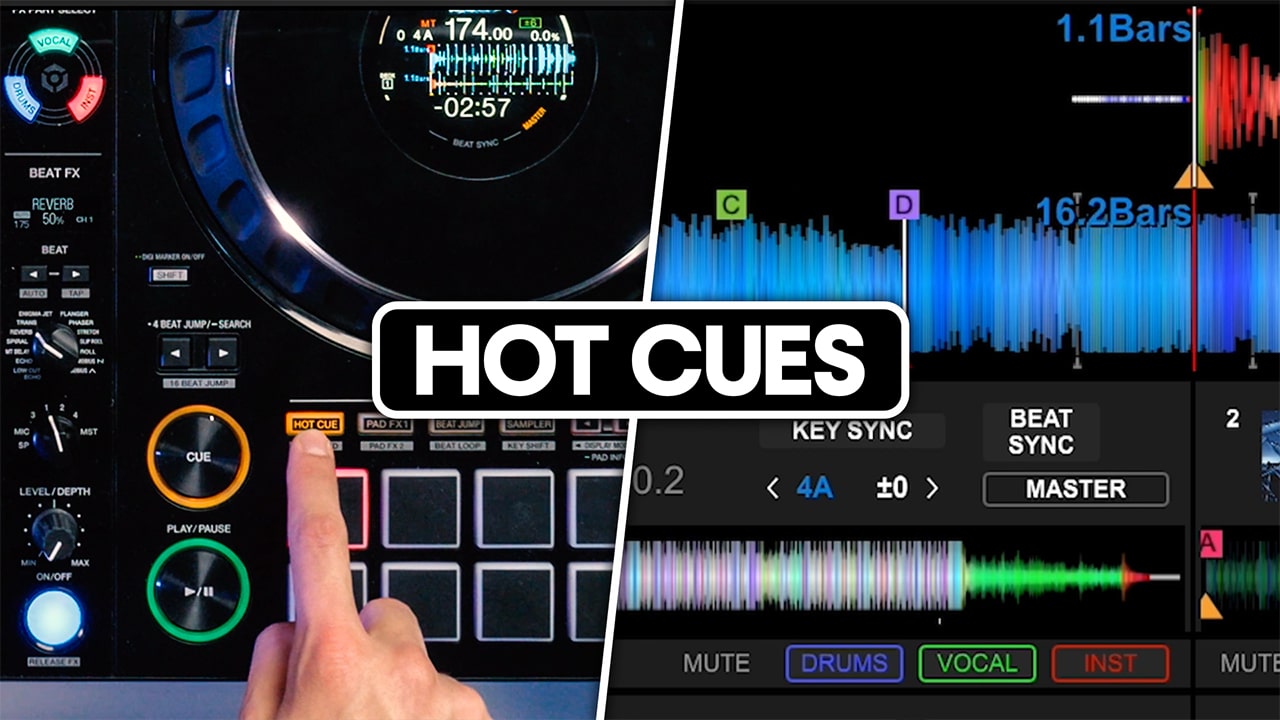
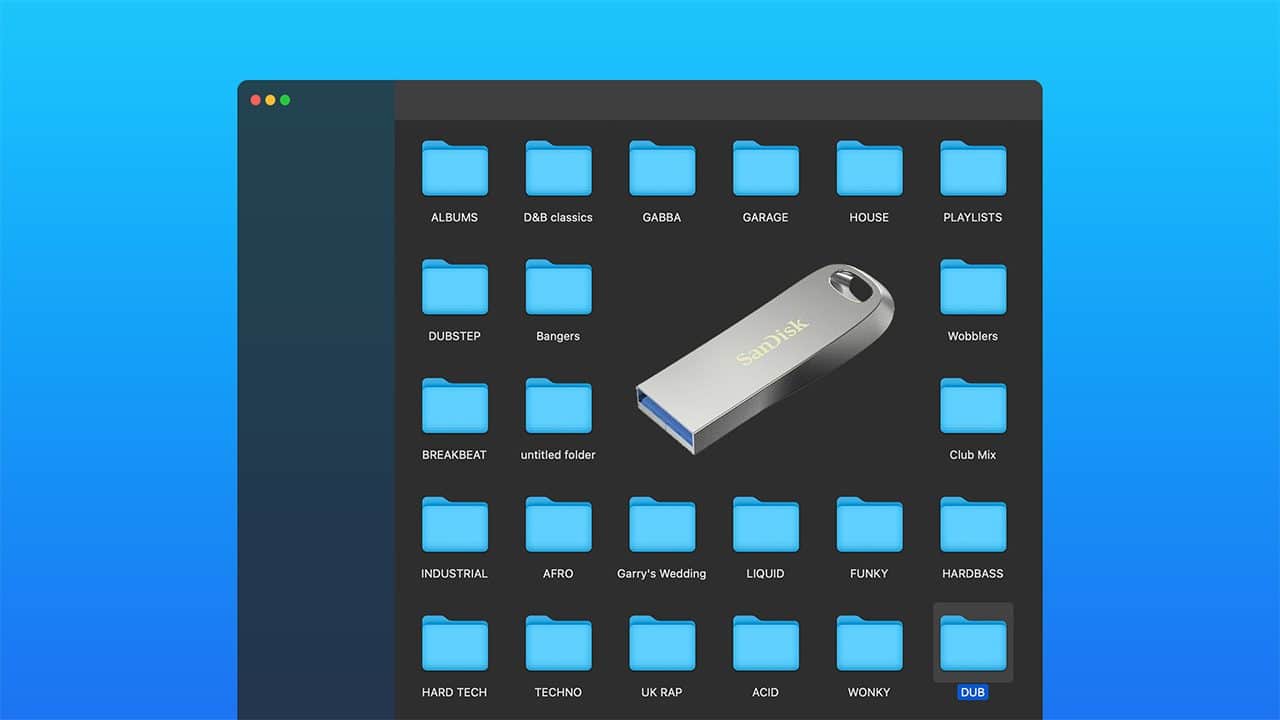
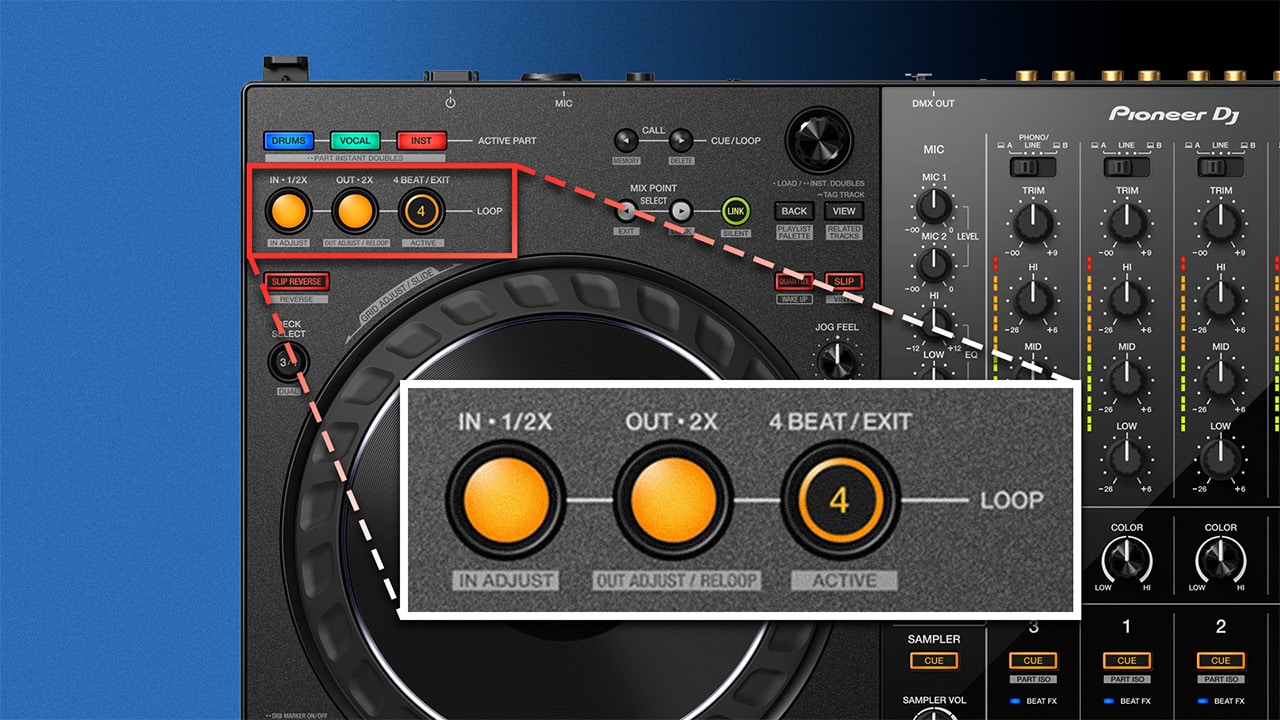
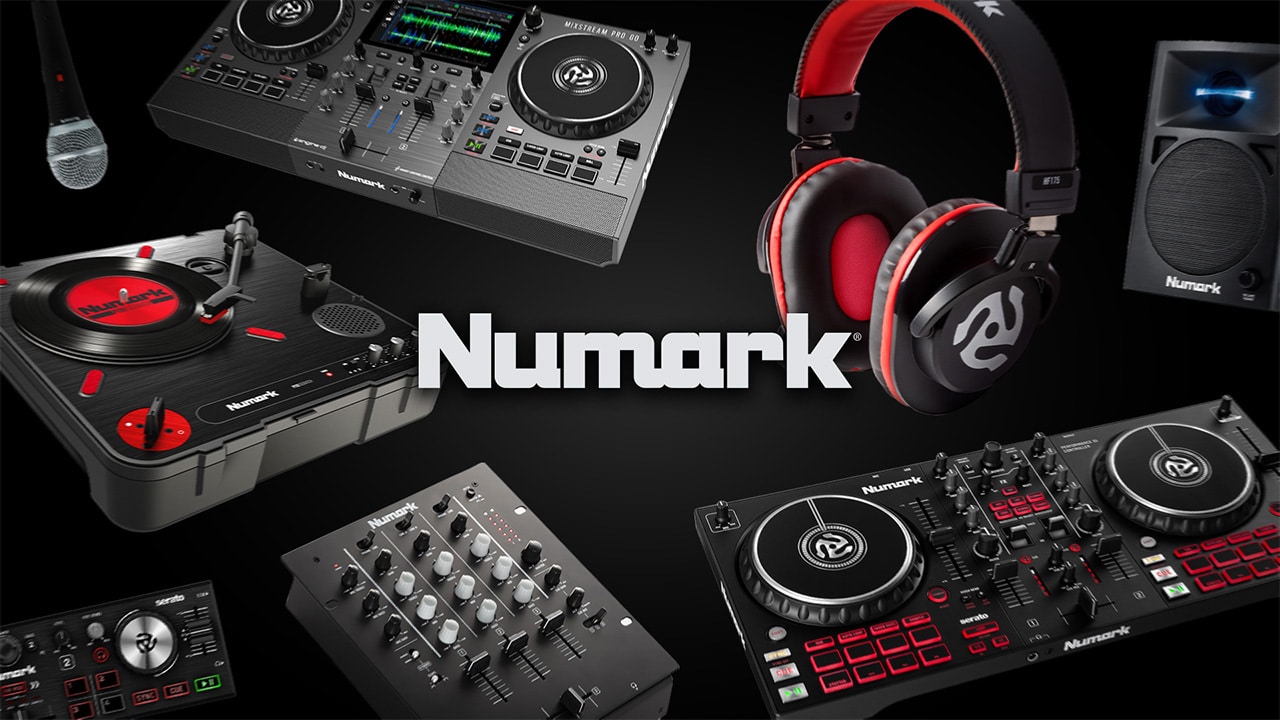
0 Comments